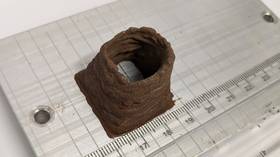Blood, sweat & tears: Scientists suggest astronaut BODILY FLUIDS could be used to produce concrete on Mars

Building a base on the Red Planet might literally take blood, sweat, and tears to achieve – a new study suggests the bodily fluids of astronauts sent to colonize Mars could be used to supply the water needed for construction.
The unconventional approach to extraplanetary construction was put forward by scientists at the UK’s University of Manchester in a research paper published this month in the journal Materials Today Bio.
Delivering building materials to the Red Planet from Earth would be an extremely inefficient and costly process, with in-situ resource utilization being the best option for construction of bases on other planets. According to earlier estimates, delivery of a single brick to Mars would cost roughly $2 million, the scientists noted, suggesting future colonists should make their own concrete on site instead.
Also on rt.com WATCH: Russian Soyuz rocket launches 34 satellites into orbit as part of mission to expand internet coverage throughout globeWhile Mars’ regolith soil – a blanket of loose rock and dust that sits atop a layer of bedrock – has plenty of mineral deposits that could be used for concrete production, it lacks the water required to bind them together. But the colonists could utilize their bodily fluids instead, the study suggested.
“Scientists have been trying to develop viable technologies to produce concrete-like materials on the surface of Mars, but we never stopped to think that the answer might be inside us all along,” one of the researchers, Dr Aled Roberts, has said.
To prove their point, his team produced a concrete-like material from synthetic regolith bound with a protein from human blood plasma. The scientists successfully used their ‘AstroCrete’ to produce 3D-printed bricks.
The material turned out to be nearly as strong as regular concrete. AstroCrete’s compressive strength was as high as 25 MPa, compared to the 20-30Mpa of concretes made with conventional ingredients. And adding other bodily fluids into the mix could make it even stronger.
“The incorporation of urea – which could be extracted from the urine, sweat, or tears of astronauts – could further increase the compressive strength by over 300% in some instances, with the best-performing formulation having an average compressive strength of 39.7 MPa,” the study reads.
Also on rt.com SpaceX launches Inspiration4 from Florida as part of historic all-civilian space missionUsing blood – albeit not human – as a binder is not a new idea, the researchers noted. Back in the Middle Ages, animal blood was commonly used to bind mortar.
“It is exciting that a major challenge of the space age may have found its solution based on inspirations from medieval technology,” Dr Roberts said.
According to the scientists’ estimates, a team of six colonists could produce over 500kg (1,000lb) of AstroCrete over the course of a two-year mission on the surface of Mars without incurring any personal harm. Such rates would allow them to expand a potential base twofold in a single mission, with every colonist providing enough material to build a habitat for another crew member.
Think your friends would be interested? Share this story!














